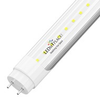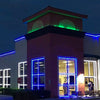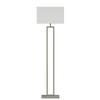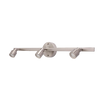LED technology, also known as solid-state lighting, has been around for some time now. LED light bulbs mimic the various hues of white light, ranging from that produced by a candle (warm white) to bright day-like (daylight) white. While conventional lighting products (such as metal halides, CFLs, fluorescents, etc.) offer a lower efficiency, LEDs are more energy-efficient. Unlike traditional lights, LEDs convert large amounts of input energy into light. Thus, LED light bulbs are like a safe-harbor in all the general, ambient, decór, task, and emergency lighting projects.
Wattage and Lumen output is not the same

It was a common practice to focus on the wattage rating of metal halide bulbs. Back in the days of traditional lighting fixtures, a notion that higher a wattage rating means better light output was in favor. However, when it comes to LED bulbs, you must look out for lumen output. Wattage ratings have nothing to do with the luminosity or luminous flux (lumen output) of light bulbs.
The wattage rating on a light bulb is a product of the amount of voltage and current that it needs. In simple words, watts tell the power consumption. A 100W metal halide that works on a 120V supply doesn’t provide the same lumen output as a 60W LED bulb. Metal halides consume electrical input and convert substantial amounts of energy into heat, putting out average light production. Whereas, LED light bulbs convert up to 90% of input energy into light. Hence, unlike older light bulbs, LEDs stay cooler even during long-hour operations.
In general, LED light bulb manufacturers mention two different wattage ratings on the package. While one of the ratings tells the bulb’s energy consumption, the other suggests its non-LED equivalent. So when you see a 12W LED lamp with a 100W marking, know that the former is its ‘actual wattage’ while the later is ‘wattage equivalent.’
Get bulbs in the right lumen output
LED lamps are available in several lumen outputs. Knowing how much light will be sufficient for indoor space is crucial for creating the desired ambiance. An average bedroom that measures 11” X12” X10” will need three 9W LED bulbs to achieve appropriate general lighting. Installing the lights far from the corners (yet, not in the center) will illuminate the entire room. On the other hand, master bedroom measuring 14” X 16” X 10” will need four 9W bulbs for the same level of illumination.
The above calculation is for bedrooms that highlight light-colored walls and ceiling. Rooms with dark-colored walls will need higher lumen outputs. You can meet a bedroom’s general lighting needs by installing a single LED bulb that offers a high lumen output or three to four bulbs wit lower lumen outputs.
Once the general lighting seems sufficient, you can choose to mix and match various kinds of LED lighting fixtures. Installing a mix of LED light bulbs, semi-flush mounts, Task lights, LED rope/strip lights, and wall sconces will help you with completing the lighting design of a bedroom. You can choose different LEDs in various Correlated Color Temperatures and experience a seamless flow of multiple tones of white across the bedroom. Continue reading to know more about LED colors and color temperatures.

Correlated Color Temperatures and lighting design
You know how strawberries taste, and you also know the taste of strawberry-flavored drinks. Both are similar, yet you can notice a slight difference between the two. You can tell that a strawberry is a natural fruit, while flavored drinks mimic its taste.
Similarly, LED lights to mimic the illumination of various natural light sources, such as a candle (warm-white tone), the sky (cool-white tone), or broad daylight (daylight-white tone). Thus, the hue of different LEDs correlates various natural light sources.
Correlated color temperature (CCT) has become an essential characteristic of LED lighting fixtures. Warm-white illumination papers like the light coming from incandescent and metal halide bulbs. Installing LED lights with a CCT of 3000-4000K (warm-white) will let you treat the eyes with a cozy and nostalgic warm-white lighting effect.
A little care can go a long way
You know about the wattage, lumen output, and CCT of LED light bulbs. However, you must understand that LED lighting fixtures are ‘constant-voltage’ electrical devices. Meaning that LED lights maintain a constant value of current, regardless of the source voltage.
The brightness of LED lights depends on the type of semiconductor and has little to do with the voltage. LEDs can work on lower voltages, but high supply can degrade the LED light components. In worst-case scenarios, a power surge may short the circuitry on an LED and burn it out. Contrary to voltage-spikes, LEDs will be maintaining a threshold and still work during a power drop event. So, don’t fool yourself into thinking that feeding higher energy to an LED that works on 120-227V supply will provide more luminescence (brightness).
Most indoor and outdoor LED lights come with drivers that maintain a constant electrical supply. Thus, being mindful of the power supply can help maintain the longevity of LED lighting fixtures. Keeping a check on the LED use-cycles and choosing lighting fixtures and choosing task-specific LEDs will ensure that an installation stands up to the manufacturer’s promise!
LED Light Bulbs: the new age lighting fixtures!
LED bulbs are available in a variety of designs, sizes, lumen outputs, and CCTs. Thus, you have the freedom to choose the most energy-saving lights in several styles. From the classic A19 bulb with an E26 base to a PL bulb with a four-pin GX base, LED light bulbs offer a plethora of options. Each base style allows you to excess a different socket, while the bulb shape has more to do with light distribution and aesthetics.
At LEDMyplace, we have a team of LED product experts who guide our customers and help decide on the right lighting fixtures. So, if you feel the need to learn more about specific LED lights, feel free to contact us!




















































































